tires Lexus IS250 2006 Using the audio system / LEXUS 2006 IS350/250 THROUGH APRIL 2006 PROD. (OM53508U) Owner's Guide
[x] Cancel search | Manufacturer: LEXUS, Model Year: 2006, Model line: IS250, Model: Lexus IS250 2006Pages: 433, PDF Size: 10.9 MB
Page 385 of 433

5
When trouble arises
367
5-2. Steps to take in an emergency
If the vehicle becomes stuck
CAUTION
■When attempting to free a stuck vehicle
If you choose to rock the vehicle back and forth to free it, make sure the surround-
ing area is clear, to avoid striking other vehicles, objects or persons. The vehicle
may also lunge forward or lunge back suddenly as it becomes free. Use extreme
caution.
■When shifting the shift lever
With automatic transmission vehicles, be careful not to shift the shift lever with the
accelerator pedal depressed.
This may lead to unexpected rapid acceleration of the vehicle that may cause an
accident and result in death or serious injury.
NOTICE
■To avoid damaging the transmission and other components
●Avoid spinning the wheels and do not rev the engine.
●If the vehicle remains stuck after trying these procedures, the vehicle may require
towing to be freed.
Carry out the following procedures if the tires spin or the vehicle becomes
stuck in mud, dirt, or snow.
● Stop the engine. Set th e parking brake and put the selector lever
in P (vehicles with an automatic transmission) or N (vehicles with
a manual transmission).
● Remove the mud, snow, or sand from around the stuck tire.
● Place wood, stones or some other material to help provide trac-
tion under the tires.
● Restart the engine.
● For 2WD vehicles only: Turn the traction control OFF. ( P. 141)
● Carefully apply the accelerator to free the vehicle.
Page 388 of 433
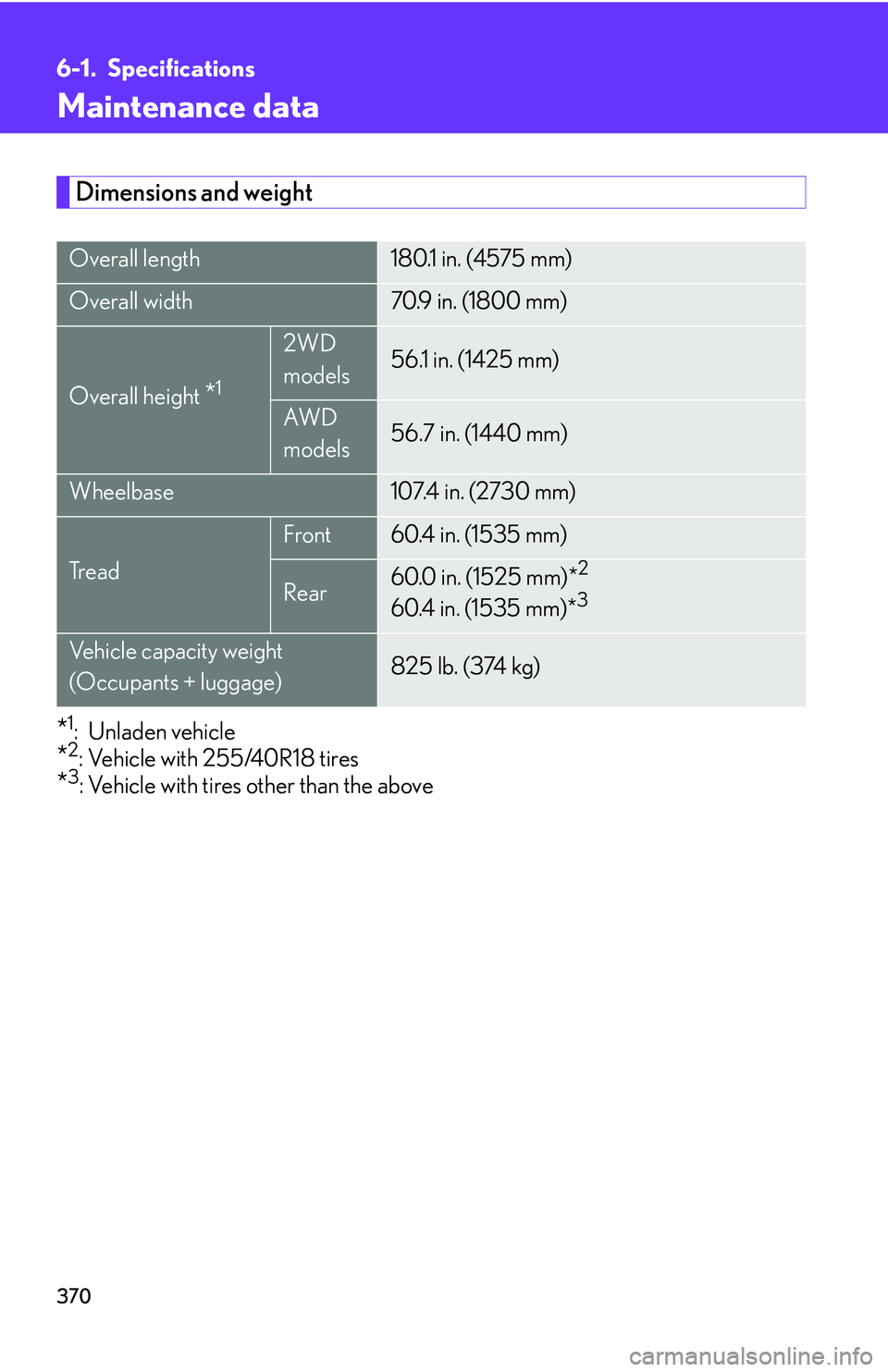
370
6-1. Specifications
Maintenance data
Dimensions and weight
*1: Unladen vehicle
*2: Vehicle with 255/40R18 tires
*3: Vehicle with tires other than the above
Overall length180.1 in. (4575 mm)
Overall width70.9 in. (1800 mm)
Overall height *1
2WD
models56.1 in. (1425 mm)
AW D
models56.7 in. (1440 mm)
Wheelbase107.4 in. (2730 mm)
Tr e a d
Front60.4 in. (1535 mm)
Rear60.0 in. (1525 mm)*2
60.4 in. (1535 mm)*3
Vehicle capacity weight
(Occupants + luggage)825 lb. (374 kg)
Page 396 of 433
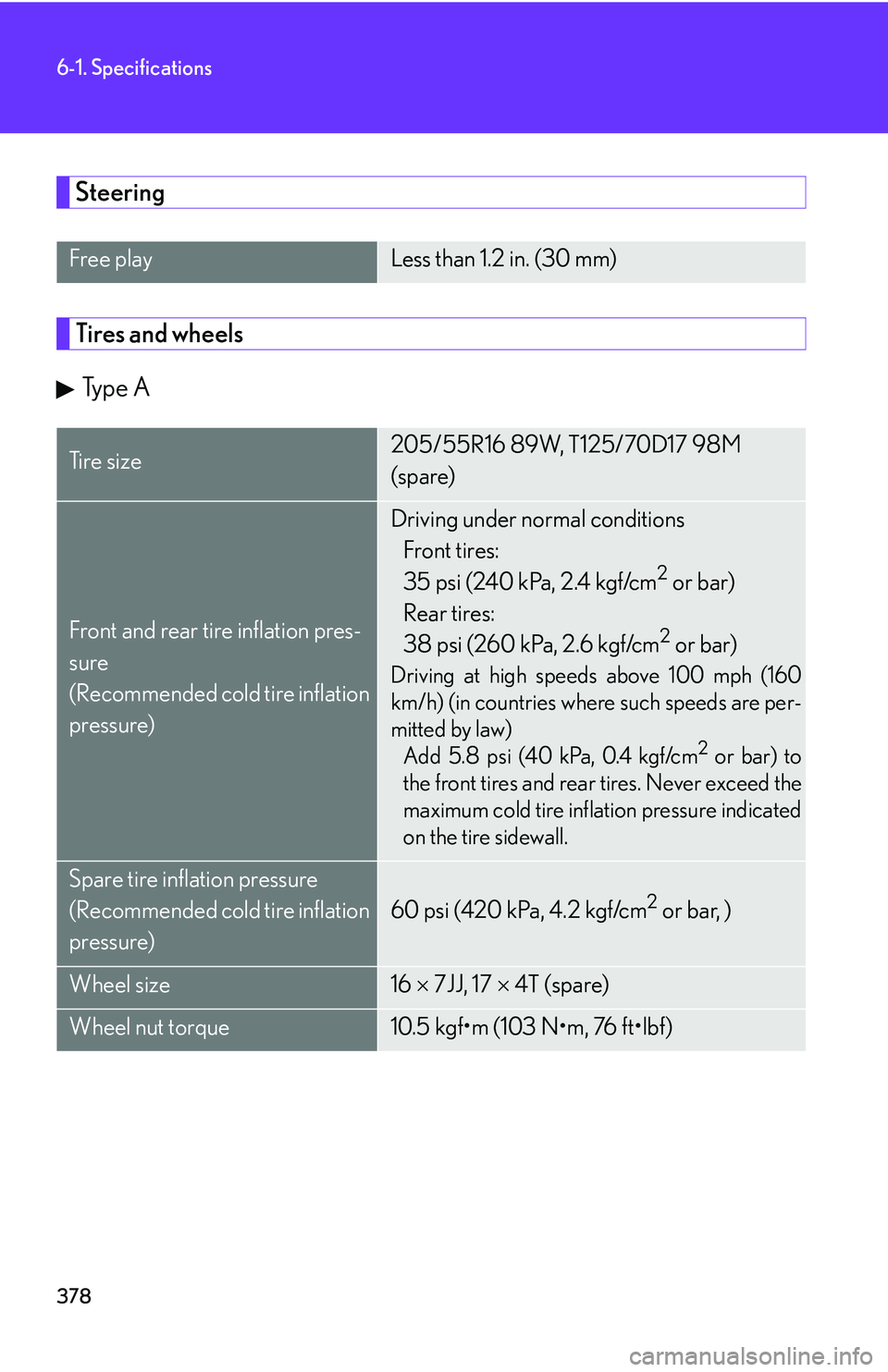
378
6-1. Specifications
Steering
Tires and wheelsTy p e A
Free playLess than 1.2 in. (30 mm)
Ti r e s i z e205/55R16 89W, T125/70D17 98M
(spare)
Front and rear tire inflation pres-
sure
(Recommended cold tire inflation
pressure)
Driving under normal conditions Front tires:
35 psi (240 kPa, 2.4 kgf/cm
2 or bar)
Rear tires:
38 psi (260 kPa, 2.6 kgf/cm
2 or bar)
Driving at high speeds above 100 mph (160
km/h) (in countries where such speeds are per-
mitted by law) Add 5.8 psi (40 kPa, 0.4 kgf/cm
2 or bar) to
the front tires and rear tires. Never exceed the
maximum cold tire inflation pressure indicated
on the tire sidewall.
Spare tire inflation pressure
(Recommended cold tire inflation
pressure)
60 psi (420 kPa, 4.2 kgf/cm2 or bar, )
Wheel size16 7JJ, 17 4T (spare)
Wheel nut torque10.5 kgf•m (103 N•m, 76 ft•lbf)
Page 397 of 433
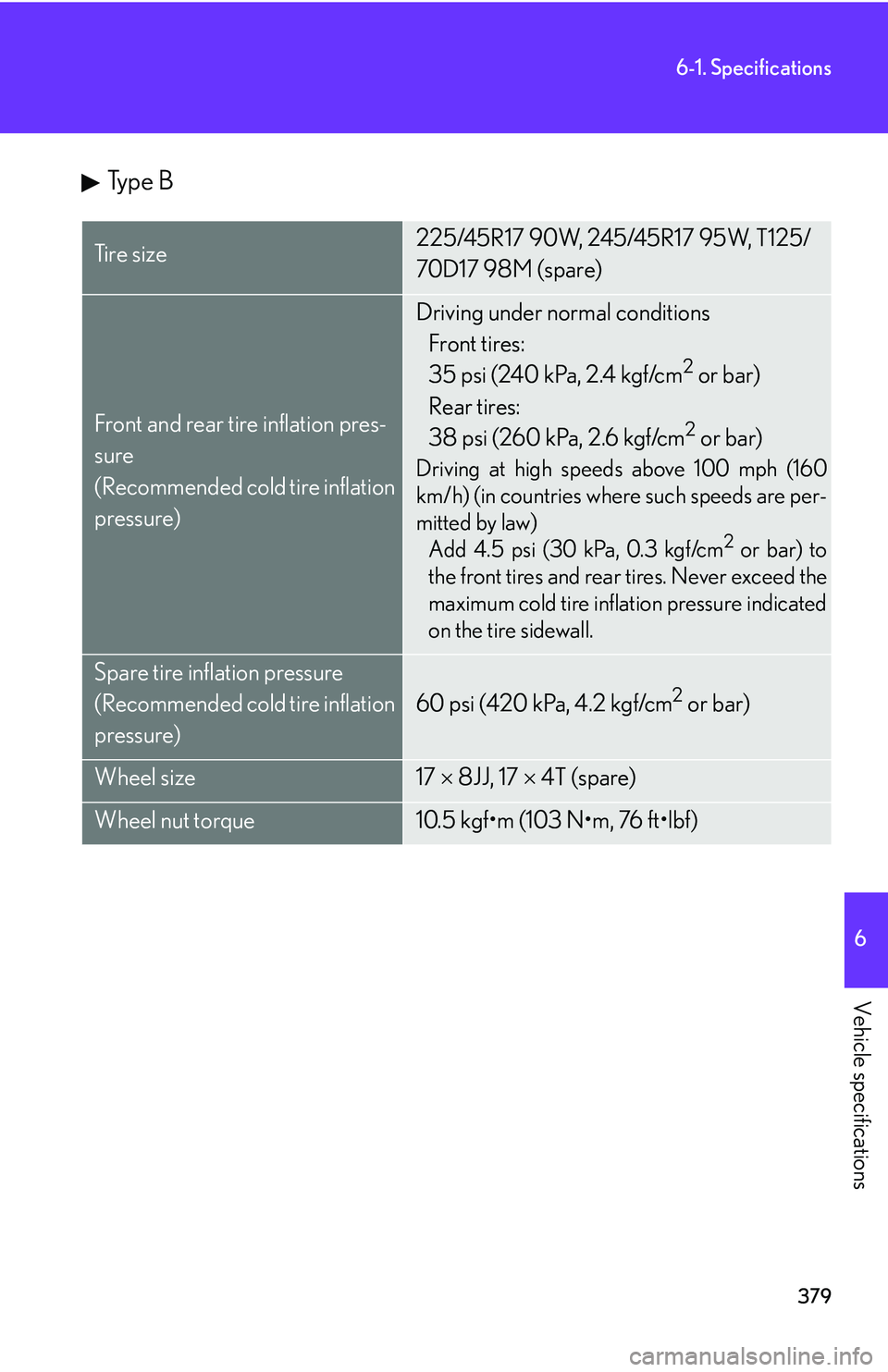
379
6-1. Specifications
6
Vehicle specifications
Type B
Ti r e s i z e225/45R17 90W, 245/45R17 95W, T125/
70D17 98M (spare)
Front and rear tire inflation pres-
sure
(Recommended cold tire inflation
pressure)
Driving under normal conditionsFront tires:
35 psi (240 kPa, 2.4 kgf/cm
2 or bar)
Rear tires:
38 psi (260 kPa, 2.6 kgf/cm
2 or bar)
Driving at high speeds above 100 mph (160
km/h) (in countries where such speeds are per-
mitted by law) Add 4.5 psi (30 kPa, 0.3 kgf/cm
2 or bar) to
the front tires and rear tires. Never exceed the
maximum cold tire inflation pressure indicated
on the tire sidewall.
Spare tire inflation pressure
(Recommended cold tire inflation
pressure)
60 psi (420 kPa, 4.2 kgf/cm2 or bar)
Wheel size17 8JJ, 17 4T (spare)
Wheel nut torque10.5 kgf•m (103 N•m, 76 ft•lbf)
Page 398 of 433
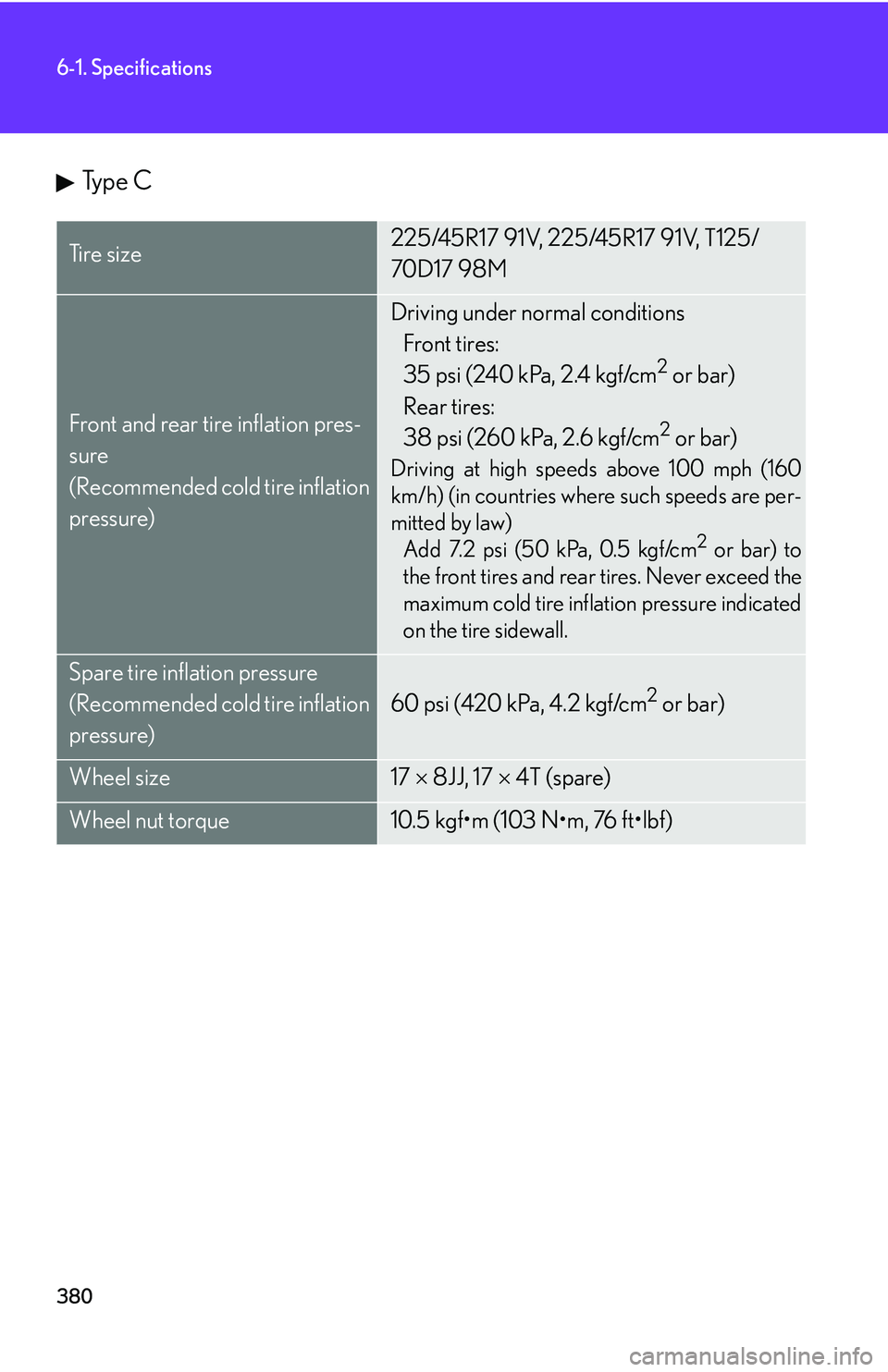
380
6-1. Specifications
Ty p e C
Ti r e s i z e225/45R17 91V, 225/45R17 91V, T125/
70D17 98M
Front and rear tire inflation pres-
sure
(Recommended cold tire inflation
pressure)
Driving under normal conditions Front tires:
35 psi (240 kPa, 2.4 kgf/cm
2 or bar)
Rear tires:
38 psi (260 kPa, 2.6 kgf/cm
2 or bar)
Driving at high speeds above 100 mph (160
km/h) (in countries where such speeds are per-
mitted by law) Add 7.2 psi (50 kPa, 0.5 kgf/cm
2 or bar) to
the front tires and rear tires. Never exceed the
maximum cold tire inflation pressure indicated
on the tire sidewall.
Spare tire inflation pressure
(Recommended cold tire inflation
pressure)
60 psi (420 kPa, 4.2 kgf/cm2 or bar)
Wheel size17 8JJ, 17 4T (spare)
Wheel nut torque10.5 kgf•m (103 N•m, 76 ft•lbf)
Page 399 of 433

381
6-1. Specifications
6
Vehicle specifications
Type D
Ti r e s i z e
Front tires: 225/45R17 95V
Rear tires: 245/45R17 95V
Spare tire: T125/70R17 98M
Front and rear tire inflation pres-
sure
(Recommended cold tire inflation
pressure)
Driving under normal conditionsFront tires:
35 psi (240 kPa, 2.4 kgf/cm
2 or bar)
Rear tires:
38 psi (260 kPa, 2.6 kgf/cm
2 or bar)
Driving at high speeds above 100 mph (160
km/h) (in countries where such speeds are per-
mitted by law) Add 10 psi (70 kPa, 0.7 kgf/cm
2 or bar) to the
front tires and rear tires. Never exceed the
maximum cold tire inflation pressure indicated
on the tire sidewall.
Spare tire inflation pressure
(Recommended cold tire inflation
pressure)
60 psi (420 kPa, 4.2 kgf/cm2 or bar)
Wheel size17 8JJ, 17 4T (spare)
Wheel nut torque10.5 kgf•m (103 N•m, 76 ft•lbf)
Page 400 of 433
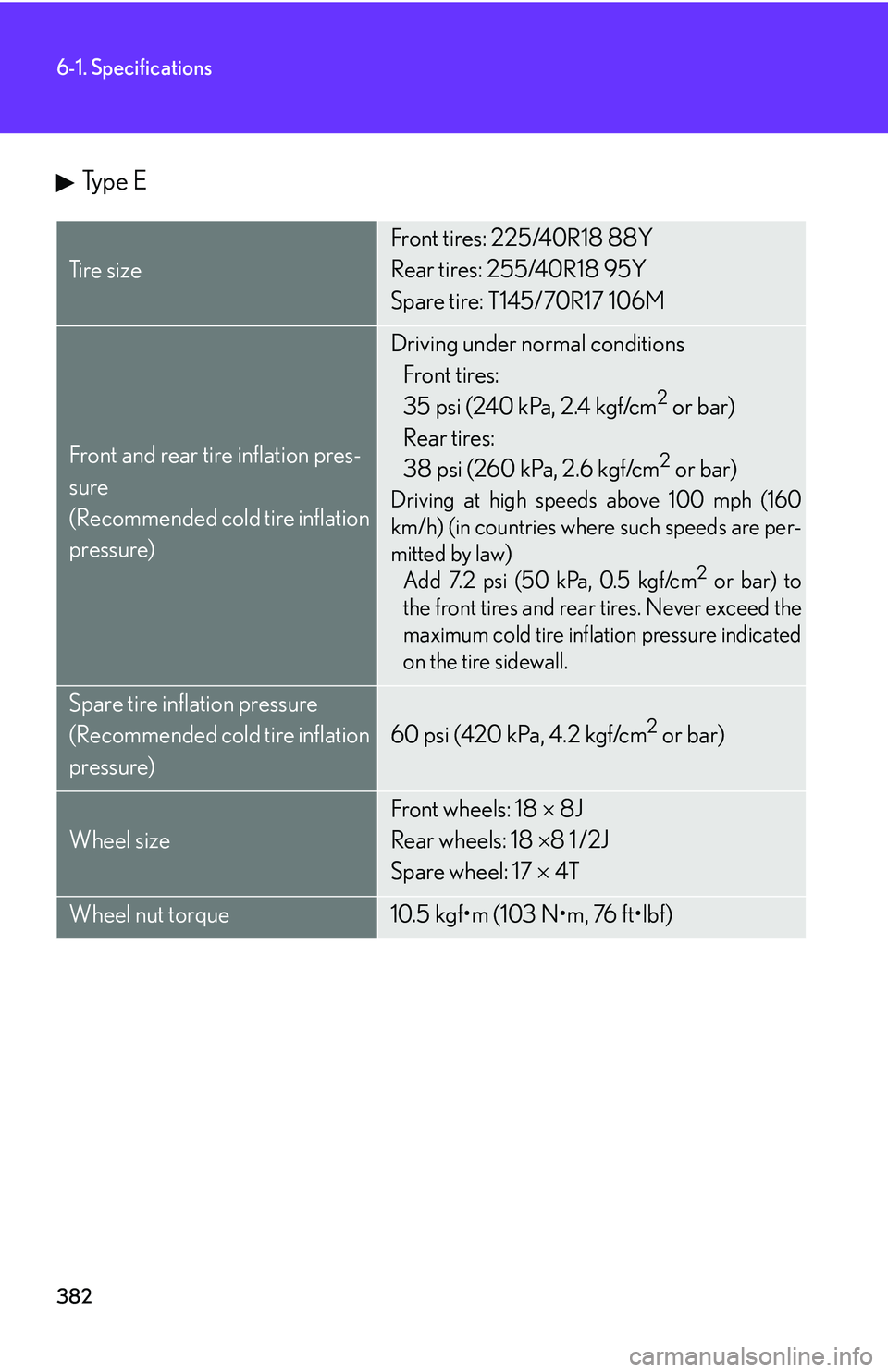
382
6-1. Specifications
Ty p e E
Ti r e s i z e
Front tires: 225/40R18 88Y
Rear tires: 255/40R18 95Y
Spare tire: T145/70R17 106M
Front and rear tire inflation pres-
sure
(Recommended cold tire inflation
pressure)
Driving under normal conditions Front tires:
35 psi (240 kPa, 2.4 kgf/cm
2 or bar)
Rear tires:
38 psi (260 kPa, 2.6 kgf/cm
2 or bar)
Driving at high speeds above 100 mph (160
km/h) (in countries where such speeds are per-
mitted by law) Add 7.2 psi (50 kPa, 0.5 kgf/cm
2 or bar) to
the front tires and rear tires. Never exceed the
maximum cold tire inflation pressure indicated
on the tire sidewall.
Spare tire inflation pressure
(Recommended cold tire inflation
pressure)
60 psi (420 kPa, 4.2 kgf/cm2 or bar)
Wheel size
Front wheels: 18 8J
Rear wheels: 18 8 1 /2J
Spare wheel: 17 4T
Wheel nut torque10.5 kgf•m (103 N•m, 76 ft•lbf)
Page 405 of 433
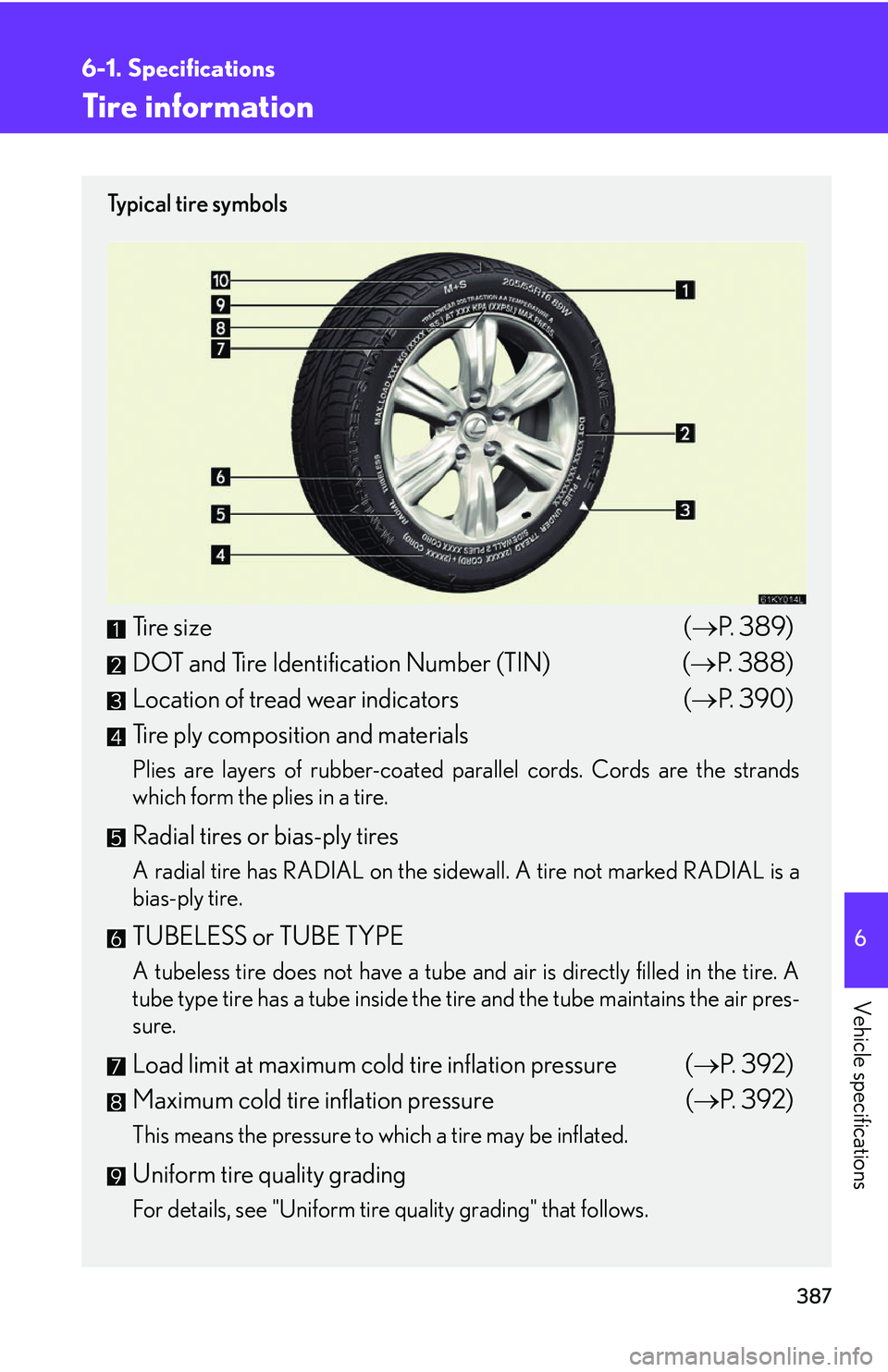
387
6-1. Specifications
6
Vehicle specifications
Tire information
Ty p i c a l t i r e s y m b o l s
Tire size(P. 389)
DOT and Tire Identification Number (TIN) ( P. 388)
Location of tread wear indicators ( P. 390)
Tire ply composition and materials
Plies are layers of rubber-coated parallel cords. Cords are the strands
which form the plies in a tire.
Radial tires or bias-ply tires
A radial tire has RADIAL on the sidewall. A tire not marked RADIAL is a
bias-ply tire.
TUBELESS or TUBE TYPE
A tubeless tire does not have a tube an d air is directly filled in the tire. A
tube type tire has a tube inside the ti re and the tube maintains the air pres-
sure.
Load limit at maximum cold tire inflation pressure ( P. 3 9 2 )
Maximum cold tire inflation pressure ( P. 3 9 2 )
This means the pressure to which a tire may be inflated.
Uniform tire quality grading
For details, see "Uniform tire quality grading" that follows.
Page 408 of 433
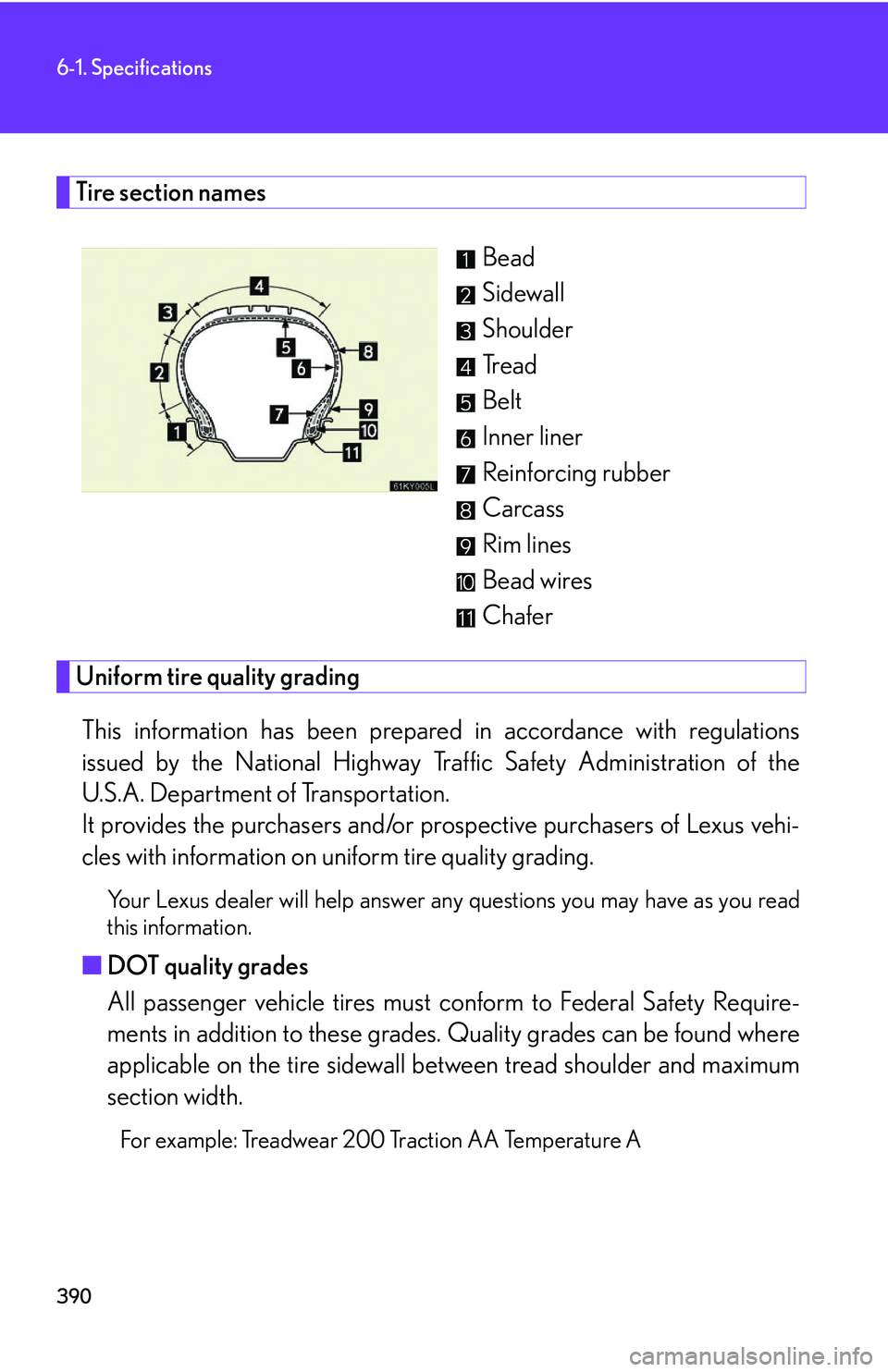
390
6-1. Specifications
Tire section namesBead
Sidewall
Shoulder
Tread
Belt
Inner liner
Reinforcing rubber
Carcass
Rim lines
Bead wires
Chafer
Uniform tire quality gradingThis information has b een prepared in accorda nce with regulations
issued by the National Highway Tr affic Safety Administration of the
U.S.A. Department of Transportation.
It provides the purchasers and/or prospective purchasers of Lexus vehi-
cles with information on uniform tire quality grading.
Your Lexus dealer will help answer an y questions you may have as you read
this information.
■ DOT quality grades
All passenger vehicle tires must co nform to Federal Safety Require-
ments in addition to these grades. Quality grades can be found where
applicable on the tire sidewall between tread shoulder and maximum
section width.
For example: Treadwear 200 Traction AA Temperature A
Page 409 of 433

391
6-1. Specifications
6
Vehicle specifications
■Treadwear
The treadwear grade is a comparative rating based on the wear rate of
the tire when tested under controll ed conditions on a specified gov-
ernment test course.
For example, a tire graded 150 would wear one and a half (1 - 1 /2) times as
well on the government course as a tire graded 100.
The relative performance of tires de pends upon the actual conditions of
their use, however, and may depart significantly from the norm due to varia-
tions in driving habits, service practices and differences in road characteris-
tics and climate.
■ Traction AA, A, B, C
The traction grades, from highest to lowest, are AA, A, B and C, and
they represent the tire's ability to stop on wet pavement as measured
under controlled condit ions on specified government test surfaces of
asphalt and concrete.
A tire marked C may have poor traction performance.
Warning: The traction grade assigned to this tire is based on braking
(straight ahead) traction tests and does not include cornering (turning) trac-
tion.
■ Temperature A, B, C
The temperature grades are A (the hi ghest), B, and C, representing
the tire's resistance to the generation of heat and its ability to dissipate
heat when tested under controlled conditions on a specified indoor
laboratory test wheel.
Sustained high temperature can cause the material of the tire to degenerate
and reduce tire life, and excessive temperature can lead to sudden tire fail-
ure.
The grade C corresponds to a level of performance which all passenger car
tires must meet under the Federal Mo tor Vehicle Safety Standard No. 109.
Grades B and A represent higher levels of performance on the laboratory
test wheel than the minimum required by law.